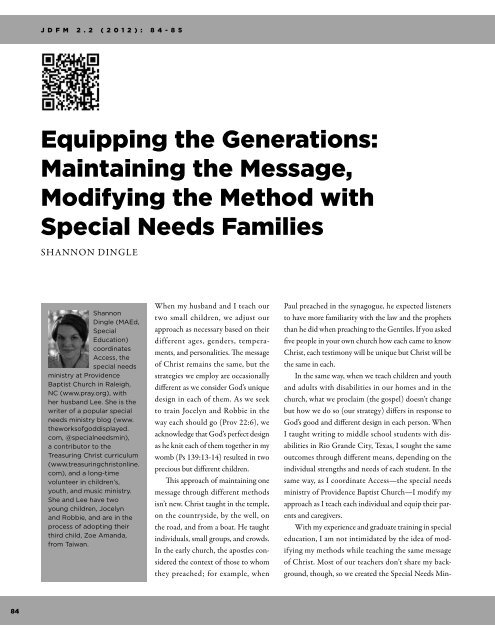here - The Southern Baptist Theological Seminary
here - The Southern Baptist Theological Seminary
here - The Southern Baptist Theological Seminary
You also want an ePaper? Increase the reach of your titles
YUMPU automatically turns print PDFs into web optimized ePapers that Google loves.
J DFM 2.2 (2012): 84-85<br />
Equipping the Generations:<br />
Maintaining the Message,<br />
Modifying the Method with<br />
Special Needs Families<br />
SHANNON DINGLE<br />
Shannon<br />
Dingle (MAEd,<br />
Special<br />
Education)<br />
coordinates<br />
Access, the<br />
special needs<br />
ministry at Providence<br />
<strong>Baptist</strong> Church in Raleigh,<br />
NC (www.pray.org), with<br />
her husband Lee. She is the<br />
writer of a popular special<br />
needs ministry blog (www.<br />
theworksofgoddisplayed.<br />
com, @specialneedsmin),<br />
a contributor to the<br />
Treasuring Christ curriculum<br />
(www.treasuringchristonline.<br />
com), and a long-time<br />
volunteer in children’s,<br />
youth, and music ministry.<br />
She and Lee have two<br />
young children, Jocelyn<br />
and Robbie, and are in the<br />
process of adopting their<br />
third child, Zoe Amanda,<br />
from Taiwan.<br />
When my husband and I teach our<br />
two small children, we adjust our<br />
approach as necessary based on their<br />
different ages, genders, temperaments,<br />
and personalities. <strong>The</strong> message<br />
of Christ remains the same, but the<br />
strategies we employ are occasionally<br />
different as we consider God’s unique<br />
design in each of them. As we seek<br />
to train Jocelyn and Robbie in the<br />
way each should go (Prov 22:6), we<br />
acknowledge that God’s perfect design<br />
as he knit each of them together in my<br />
womb (Ps 139:13-14) resulted in two<br />
precious but different children.<br />
This approach of maintaining one<br />
message through different methods<br />
isn’t new. Christ taught in the temple,<br />
on the countryside, by the well, on<br />
the road, and from a boat. He taught<br />
individuals, small groups, and crowds.<br />
In the early church, the apostles considered<br />
the context of those to whom<br />
they preached; for example, when<br />
Paul preached in the synagogue, he expected listeners<br />
to have more familiarity with the law and the prophets<br />
than he did when preaching to the Gentiles. If you asked<br />
five people in your own church how each came to know<br />
Christ, each testimony will be unique but Christ will be<br />
the same in each.<br />
In the same way, when we teach children and youth<br />
and adults with disabilities in our homes and in the<br />
church, what we proclaim (the gospel) doesn’t change<br />
but how we do so (our strategy) differs in response to<br />
God’s good and different design in each person. When<br />
I taught writing to middle school students with disabilities<br />
in Rio Grande City, Texas, I sought the same<br />
outcomes through different means, depending on the<br />
individual strengths and needs of each student. In the<br />
same way, as I coordinate Access—the special needs<br />
ministry of Providence <strong>Baptist</strong> Church—I modify my<br />
approach as I teach each individual and equip their parents<br />
and caregivers.<br />
With my experience and graduate training in special<br />
education, I am not intimidated by the idea of modifying<br />
my methods while teaching the same message<br />
of Christ. Most of our teachers don’t share my background,<br />
though, so we created the Special Needs Min-<br />
84
















